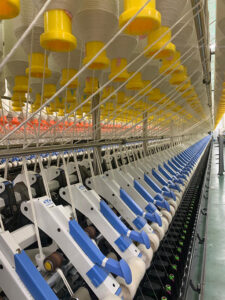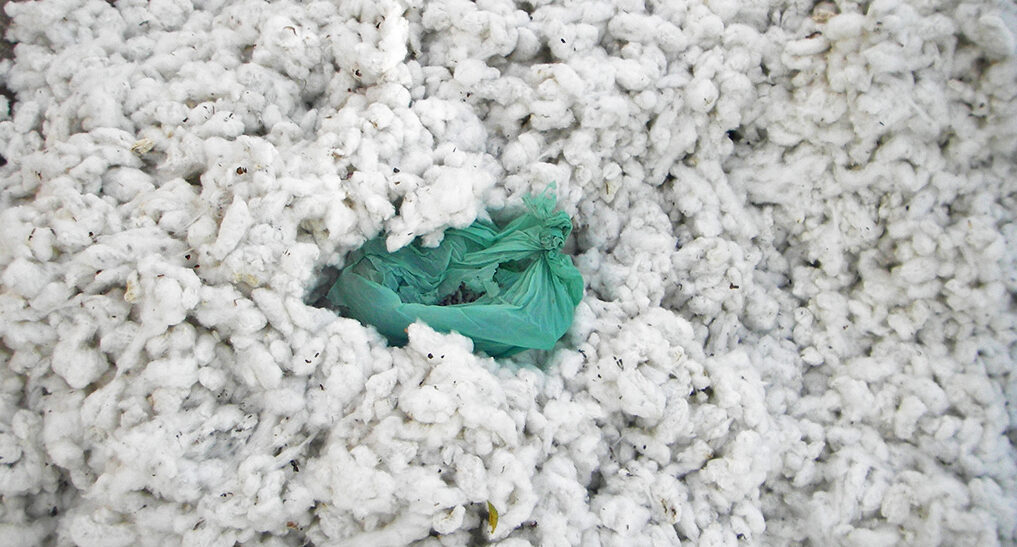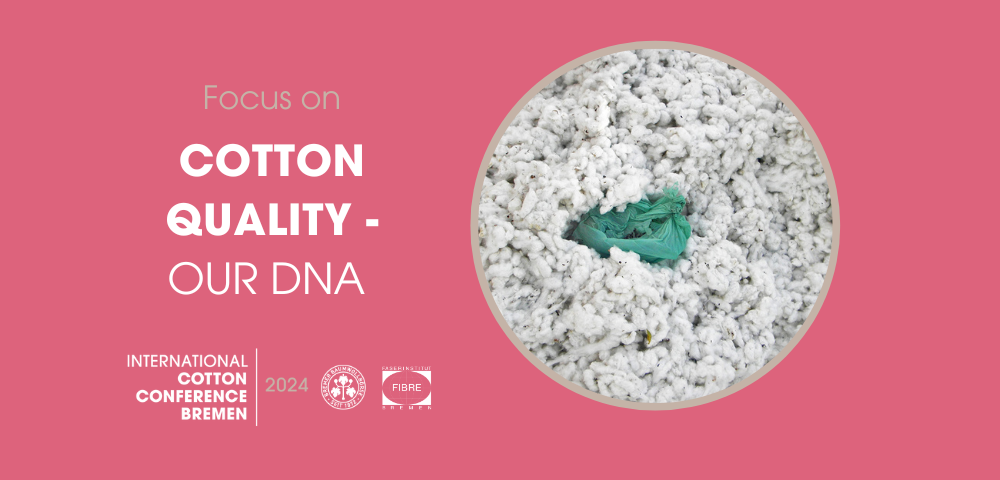Bremen, 23 February 2024: The 37th International Cotton Conference starts in Bremen in less than a month. For the approximately 400 people attending, an exciting blend of scientific and practical topics from the international cotton supply chain awaits both in Bremen and online.
Cotton quality – from the field to ginning and spinning
Yarn and raw material quality is the basis for all types of textile products. With the focus on cotton quality and quality testing, the effect of ginning and cleaning in the preliminary stage, as well as innovations in spinning technology, the conference is dedicated to its origins. Scientists and practical experts from around the globe will present the latest developments along with promising research findings. These include the successful spinning of natural fibres such as hemp and cotton, as well as the fact that the quality of yarns is being continually improved.
Quality production in spinning and textile processing

Ring spinning is one of the leading, most versatile methods for producing yarn from different materials. However, in terms of productivity, it lies behind other techniques. The reason: the process generates friction heat of up to 400°C, often resulting in thread breakage with machine downtimes and a negative impact on yarn quality. Mahmud Hossain from the Institute of Textile Machinery and High Performance Material Technology at the Technical University in Dresden will present a procedure developed in conjunction with the Leibnitz Institute of Polymer Research in Dresden, which eliminates the friction generated during the twisting of spun thread, enabling high-quality yarns to be manufactured from natural and chemical fibres even at high processing speeds of up to 50,000 rpm.
Hemp and cotton in spinning: In light of sustainability debates, the spinning of hemp into a blend with cotton fibres is becoming increasingly important. Ralf Müller from the textile machinery manufacturer Trützschler, Mönchengladbach, will illustrate in his presentation how these natural fibres can be spun together to form quality yarns.
There is great anticipation surrounding the lecture by Jaswinder Bedi, one of the leading figures of various textile associations on the African continent. He is also the CEO of Bedi Investments Ltd. and Executive Director of Fine Spinners Uganda Ltd. As part of his role, he is continually working to develop vertically integrated strategies from cotton cultivation through to the finished product, thereby generating export opportunities for high-quality textile products manufactured in African countries.
Testing cotton quality – from field to preliminary stage
Recurring problems with the stickiness of supplied cotton can result in considerable disruptions to the process, reducing the productivity of procedures in the textile industry. For years, research into methods for accurately determining the levels of stickiness in cotton has become increasingly important. The International Committee on Cotton Testing Methods (ICCTM), in particular, has made a name for itself in this respect. Jean-Paul Gourlot from the French Agricultural Research Centre for International Development (CIRAD) in Montpellier will present the latest findings as a member of the ICCTM.

Mourad Krifa from Kent State University, Oklahoma, USA will make clear how typical impurities in seed cotton, e.g. due to leaf and bark residues, grass or seed coat residues as well as dirt, can affect the test results of High-Volume Instrument (HVI) tests. He will look, in particular, at the influence of individual dirt particles on the test results.
Deninson Lima from the Brazilian Cotton Growers Association ABRAPA in Brasilia will report on the development of the ‘Standard Brazil HVI Programme’ (SBRHVI). In international competition, ABRAPA drove forward a universal instrumental quality test that complied with international standards. The consistent use of modern test procedures and the resulting reliable quality labelling has led to an increase in the economic value of the raw material since 2017.
Efstratios Fragkotsinos from Swiss test instrument manufacturer Uster Technologies will emphasise the importance of cotton bale management in spinning mills. In his opinion, an eye must be kept on both the quality and profitability. Cotton usage can be optimised in relation to the desired fibre and yarn qualities as well as the storage space used.
Cotton ginning and its effect on fibre quality

Moisture control plays a crucial role when processing cotton. Justin Kühn from the Institute of Textile Technology at RWTH Aachen University will ask whether the methods for controlling the raw material moisture at pre-spinning stage or during the ginning process have a decisive influence over fibre quality. He will present findings from the latest scientific research. According to his observations, only rarely has moisture management been practised to date in the early stages of natural fibre processing.
In his presentation, Marinus van der Sluijs from Textile Technical Services in Australia will compare the results of cleaning cotton at ginning stage with those during preliminary stages at the spinning mill, in particular in terms of the desired quality of the raw material for further processing. The at first glance astonishing conclusion is that cotton that was cleaned the least makes for a better-quality yarn, irrespective of the chosen cleaning stage. This lecture will focus on the question of whether a modern blowroom at the spinning mill can cope with higher quantities of waste, and the potential advantages and disadvantages for both cotton producers and the spinning mill.
Derek Whitelock from the USDA-ARS Southwestern Cotton Ginning Research Laboratory La Cruces in New Mexico, USA will present the findings of more recent tests carried out by his institute on various types of ginning machines, comparing the material quality achieved with Pima and Upland cotton.
Jaya Shankar Tumuluru, also from the USDA-ARS Southwestern Cotton Ginning Research Laboratory, will clarify within the scope of a study how the use of a pneumatic fractionator for cotton ginning affects the fibre quality of Upland cotton. Fibres processed in this way were quality tested using HVI methods. In addition to the HVI results, surface charts based on experimental data show the relationship between the process conditions and HVI properties.
Download the release: Focus on Cotton Quality – our DNA

